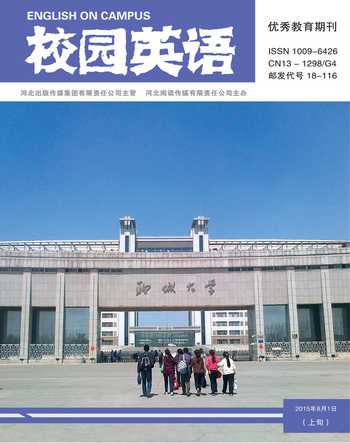ErrorAnalysisandEnglishLanguageTeachingMaJinling33Short—termMemoryTraininginListeningComprehension
2015-05-30李一菡
李一菡
【Abstract】The theory of Error Analysis is a crucial part in the research of second language acquisition and it has significant influence on exploring the pattern of English teaching.Although there are some limitations in error analysis both in theory and practice, its significant role has been proved and recognized.It is inevitable that how to scientifically treat the errors will be become more and more popular in modern English teaching.The aim of this paper is to show the importance of error analysis in English teaching and also present how well it can function in English language teaching.
【Key words】Error Analysis; English language teaching; implication; application
I.The Definition of Error Analysis
Error Analysis can be defined as an array of examinations or evaluations of learners errors and the exploration of solutions to correct the errors.It can be widely applied in many areas, particularly in second language teaching which contributes to both the teachers and second language learners.Corder (1987) did further research and he explained the significance of learners errors in three ways.For the teachers, learners errors can show the progress the learners have made and what they still need to do before achieve the goals.For the researchers, errors can show them how learners learn the language.Errors are also of great benefit to learners themselves since making mistakes is also a device to learn a language.
II.The implications of error analysis
There are also many researchers who have evaluated Error Analysis based on either their teaching experience or from other experienced teachers.Firstly with respect to the pedagogical implications, studies concerning errors are conducted in order to identify the strategies learners frequently use and the causes of learners' errors, and also to have a master of the common difficulties the learners confront with which can be regarded as an aid to develop teaching materials (Richards and Schmidt, 2002).
Also, the analysis of errors is beneficial to foreign language teachers.Corder (1973) believes that the most manifest use of Error Analysis is to the teachers.Teachers can get feedback about the effectiveness of the teaching materials they have chosen as well as the teaching techniques they have adopted.Whats more, Error Analysis plays an important role in instructing syllabus design.Kashavarz (1997) holds the view that error analysis contributes to the construction of remedial materials.
III.The Application of Error Analysis
According to what have been mentioned above, it will be highly rewarding for teachers to apply the theory of error analysis to English language teaching.With respect to the application, the procedure of error analysis should be put forward at the very beginning.Ellis and Barkhuizen (2005) indicate that there are five steps in carrying out any error analysis study including errors collection, errors identification, errors description, errors explanation and evaluation.
IV.Limitations for error analysis
According to the previous researchers there, there exist some limitations when carrying out the theory of error analysis in practice.Johansson (Johansson, 1975: 330) indicates that a thorough explanation of learners' errors can never be obtained simply by error analysis and there are also other problems and difficulties.Another problem which impedes the application of Error Analysis is that there is more than only one way to classify the errors.Many researchers have made divergent errors categorizations under different criteria.Last but not least, a question can be raised as “what if the errors are too scattered?” If the errors are not concentrated, the application may lead to a more complicated teaching and learning process.
V.Conclusion
The theory of Error Analysis is significant in conducting English teaching in many ways including pedagogical design, syllabus design, and foreign language teaching and so on.It is also expected that more solutions will be discovered to minimize the limitations.One hypothesis is that the longitudinal experiment on a specific aspect in English teaching such as the errors in English vocabulary can be carried out to expand the scale of the corpus and obtain a more comprehensive conclusion.
References:
[1]Corder,S.P.(1973):Introducing applied linguistics.Harmondsworth: Penguin.
[2]Corder,S.P.(1981):Error analysis and interlanguage.Oxford: Oxford University Press.
[3]Ellis,R.,& Barkhuizen,G.(2005): Analyzing Learner Language.Oxford: Oxford University Press.
[4]Johansson,S.(1975): 'The Uses of Error Analysis and Contrastive Analysis (II)' ELT J,1975; XXIX:330 -336.
[5]Johansson,S.(1975):'The Uses of Error Analysis and Contrastive Analysis (1)' ELT J,1975; XXIX: 246 - 253.
[6]Keshavarz,M.H.(1997): Contrastive analysis and error analysis.Tehran,Rahmana Publication.
[7]Richards,J.C.,& Schmidt,R.(2002): Dictionary of language teaching and applied linguistics.3rd Edition.Essex,Longman.
